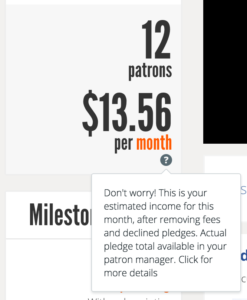 Last week, Patreon announced that it would be applying a new service fee to patron’s individual pledges. Today, after receiving plenty of feedback from creators and patrons who strongly disliked the fee change, Patreon apologized and decided not to roll out its fee change.
Last week, Patreon announced that it would be applying a new service fee to patron’s individual pledges. Today, after receiving plenty of feedback from creators and patrons who strongly disliked the fee change, Patreon apologized and decided not to roll out its fee change.
CEO and cofounder of Patreon, Jack Conte, wrote a post titled “We messed up. We’re sorry, and we’re not rolling out the fees change.” If you are on Patreon, you probably received this post in your email.
We’ve heard you loud and clear. We’re not going to rollout the changes to our payments system that we announced last week. We still have to fix the problems that those changes addressed, but we’re going to fix them in a different way, and we’re going to work with you to come up with the specifics, as we should have done the first time around. Many of you lost patrons, and you lost income. No apology will make up for that, but nevertheless, I’m sorry. It is our core belief that you should own the relationship with your fans. These are your businesses, and they are your fans.
Jack Conte pointed out that “Your feedback has been crystal clear.”
- The new payments system disproportionately impacted $1 – $2 patrons. We have to build a better system for them.
- Aggregation is highly-valued, and we understand that.
- Fundamentally, creators should own the business decisions with their fans, not Patreon. We overstepped our bounds and injected ourselves into that relationship, against our core belief as a business.
Jack Conte also acknowledged that it will take a long time to earn back the trust of creators and patrons. He states that Patreon is “utterly devoted to your success and to getting you sustainable, reliable income for being a creator.” It remains to be seen whether or not this apology will bring back the creators and patrons who left Patreon specifically because of the fee change.
 Crowdfunding platform Patreon has become a prominent monetization source for many podcasters. By default, Patreon charges backers once per month, and after it takes fees off the top of those charges, it passes payments on to Patreon creators. In response to Patreon users who’ve asked the service to make payments go thru faster, Patreon has added a new
Crowdfunding platform Patreon has become a prominent monetization source for many podcasters. By default, Patreon charges backers once per month, and after it takes fees off the top of those charges, it passes payments on to Patreon creators. In response to Patreon users who’ve asked the service to make payments go thru faster, Patreon has added a new 
 Patreon has become a popular crowdfunding platform for podcasters. And the people behind the service have taken notice. Patreon launched a new feature this week that could’ve only been inspired by the needs of podcasters;
Patreon has become a popular crowdfunding platform for podcasters. And the people behind the service have taken notice. Patreon launched a new feature this week that could’ve only been inspired by the needs of podcasters; 
 Pateron announced this week that it now has mobile apps that are available on both iOS and Android devices. Those of you who have a Patreon attached to your podcast probably received an email about this when the apps launched. Patreon also tweeted about their new apps.
Pateron announced this week that it now has mobile apps that are available on both iOS and Android devices. Those of you who have a Patreon attached to your podcast probably received an email about this when the apps launched. Patreon also tweeted about their new apps.